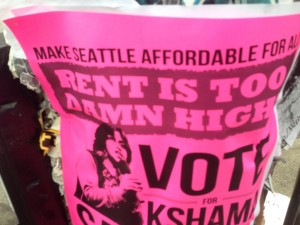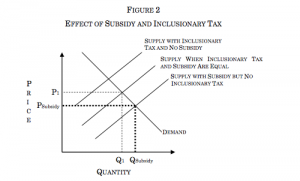More Housing, Fewer Rules, Means More Jobs, More Innovation
A recent study by Dr. Chang-Tai Hsieh and Dr. Enrico Moretti titled Growth in Cities and Countries, found that highly productive cities such as Seattle are limiting not only their own local economic potential, but also the national economic potential, by restricting their housing supply. Hsieh and Moretti call these highly productive cities “innovation clusters,” distinguished from other areas by their exceptional growth in labor demand over the last four decades. Seattle’s innovative businesses and culture has fueled the growth of companies like Microsoft and Amazon, but also many others. As they grow, they need more workers and those workers need a place to live if they move here.
However, strict anti-development land use policy in Seattle and cities of similar economic productivity has choked local housing supply, thereby reducing the labor supply available to take advantage of this demand. Insufficient and excessively expensive housing means that Seattle cannot take full advantage of its economic potential. If more workers could relocate to Seattle, they would maximize their own productivities and earn higher wages while enhancing and optimizing Seattle’s overall productivity.
This problem of inefficient labor distribution is not unique to Seattle, and when aggregated across the whole country, it leads to sizable output and welfare losses. Indeed, Hsieh and Moretti estimate that inefficiently allocated labor supply in the United States could be lowering average worker salaries by up to $7,400 per year, or, in terms of total economic output, costing us 13% of US GDP, or roughly $1.7 trillion.
Because of its naturally dynamic and innovative commercial environment, Seattle is a very economically efficient city, and by clamping down on housing supply, we limit the ability of others to add to and benefit from that efficiency. In other words, restricting housing development directly inhibits and destroys one of the greatest things our city has to offer. It is time for opponents of high-density housing development to understand that by protecting their own isolated interests, they harm the outside community to a much greater magnitude than they themselves benefit. As Hsieh and Moretti state, restricting housing supply results in “a large negative externality imposed by a minority of voters on the entire country.”
While foregoing restrictive land use policy would require some degree of sacrifice on the part of existing residents, they, along with prospective residents, the city as a whole, and the country as a whole, would all benefit greatly from the ability to better allocate labor across the country. Average wages would rise, productivities and welfare levels of cities would increase, and the strength of the US economy as a whole would improve. Ultimately, Hsieh and Moretti’s findings illustrate that relinquishing authoritative control over land use in the interest of the greater good would yield far-reaching benefits that would repay their initial sacrifice many times over.
Real Change and John V. Fox: Council is Making it Worse
What is the sure sign that something unusual is happening in politics? When unlikely people start to agree on things that really matter to them. Public opinion is coalescing against the Seattle City Council’s iterative, glitchstep, overly cautious, and insular approach to housing policy. Real Change, a publication unalterably committed to doing the right thing for people who find themselves with no housing choices at all and John V. Fox a proponent of no more growth in Seattle both agree with Smart Growth Seattle that the Seattle City Council is making it worse.
Here’s the headline of a story that posted yesterday at Real Change:
As rents rise, City Council offers few fixes to housing policy
And here’s what the reporter found when he talked to Councilmember Sally Clark:
Seattle’s approach to housing affordability is diffuse. “Seattle doesn’t have a single place where we house our housing policy,” Councilmember Sally Clark said. Instead, the city’s housing affordability strategies — incentives to developers, fees and taxes — are scattered among policies and city departments.
Doesn’t that sound familiar?
We’ve asked for a plan and urged people in the city to sign our petition urging the City Council to come up with a plan. It seems like, maybe, Councilmember Clark is listening.
“If we’re going to be successful, we’re going to have to be really intentional and more explicitly thoughtful than we have been about affordable housing,” Clark said.
Still not a commitment to a plan before using tools that won’t work for problems we don’t have. Which brings us to John V. Fox, who repeats, almost verbatim what we’ve been saying about workforce housing in an e-mail he issued yesterday.
In light of these numbers, we find it perplexing that O’Brien and his committee, and now we learn also the Mayor, have made it a priority to add to the stock of units serving those whose incomes are between 60% and 80% of median. To top it off, according to Washington State Employment Securities, the majority of the County’s wage earners (as opposed to those who receive income from investments, retirement, and the like) actually earn less than 60 percent of area median.
Why have our leaders continued to fixate on this group when the real problem is finding solutions to the shortage of units affordable to those with lower incomes? For those on the lower rungs of the income scale, it’s literally a matter of forgoing meals, healthcare, the dentist, childcare, and other necessities or become homeless.[link is mine]
That’s what we said in a post in Publicola, siting some of the same numbers Fox does.
The City Council is poised to solve a problem that we don’t have with a tool (incentive zoning) that will only make workforce housing more expensive. More fees and process would, ironically, drive up costs and prices of a housing product that is already, by the city’s standard, affordable.
So what is the problem?
Many people, of all income levels, find it frustrating to find a place to live in Seattle. Seattle needs more housing!
What is the solution?
Seattle needs to allow more housing of all types in all neighborhoods, including small-lot homes, cottages, microhousing, and multifamily housing for families who need two and three bedrooms.
Almost everyone who cares about housing is getting to the same place: the Council doesn’t get housing policy. And this is a serious problem for people who face the biggest challenges trying to find a place to live. The people and groups who are in closest touch with people who wonder where they’ll sleep tonight agree, the Council is squandering their time and power on the wrong problems and the wrong solutions. Let’s hope they hear the consensus that is forming demanding a plan to address housing for everyone in our city.
Just the Facts: Smart Sustainable Growth is Working
Opponents of high-density housing development often argue that, contrary to traditional economic theory, as the housing supply increases, the price of housing increases rather than decreases. They observe more efficient, higher-capacity buildings replacing older outdated building in their neighborhood, often accompanied by higher per-unit rents. Thus, they conclude that the ultimate goal of developers is to earn the highest profits possible at the expense of the community. While it is true that new buildings can have higher rents and that gentrification is a valid concern when it comes to redeveloping urban neighborhoods, halting analysis at this point irresponsibly places blame on the wrong parties and misses the big picture.
Firstly, it overlooks the fact that high rents are generally not due to a developer’s pursuit of profit, but rather due to the multitude of regulatory barriers developers must overcome in the building process. Such barriers significantly increase the cost of development, thus requiring developers and building managers to charge higher rents in order to make their projects financially viable under the constraints handed to them by financiers. Under the guise of claiming to protect renters’ interests, opponents of new development in their neighborhoods protect their own ‘NIMBY’-based interests by citing higher rents that result from inhibitive policy as grounds for even more regulatory restrictions for development.
However, if these individuals were truly concerned with the availability of reasonably priced housing, they would understand that the real way to lower rents is to reduce barriers to entry facing developers, thus increasing competition between suppliers. Rather than trying to enact inefficient policy to limit profit-maximization beyond socially optimal levels, why not let market forces do so? By lowering regulatory barriers, more developers could enter the market, increasing the supply of housing and creating greater competition among landlords. Though it is possible for individual new buildings to violate the general trend and have higher than average rents, overall, shifting the burden of competition away from tenants and towards landlords exerts downward pressure on housing prices.
Not only does this make logical sense from a theoretical economic perspective, but it is also supported by the data. It has taken time for the attempts to increasing housing density to take effect, but as a recent Seattle Times article reports, rents in Seattle have finally started to go down after a long period of increasing rents. Additionally, they project that rents should continue to fall for the coming months. This new data shows that while its effects may not be immediate, new development is key to reducing rents.
Furthermore, another Seattle Times article shows that Seattle has finally started growing faster than its suburbs. Plagued by the effects of an extensive highway system, large corporations settling in the suburbs, and a lack of an initial comprehensive plan between local municipalities to manage patterns of growth, much of the Seattle Metro area’s growth over the past several decades has taken the form of suburban sprawl. However, aided by increased housing supply and gradually decreasing housing costs, Seattle has recently been able to channel demographic growth more efficiently into urban areas.
Price Controls: The Emperor, The Councilwoman, and The King
It is upsetting when prices go up, and usually we complain to each other and, eventually, to our political leaders. After all, inflation consumes our savings by making our money worth less, and it consumes more of our incomes as we try to pay for life’s essentials like housing, food, and services like day care. Often the instinct of political leaders is to try to stop prices increases by just imposing a limit on them. Wouldn’t it be nice if prices for things just stopped going up? Wouldn’t it be helpful if an all-powerful leader just intervened in the market and saved us from rising prices for housing?
The Emperor
Diocletian (240-311AD) became Roman Emperor in the late third century and faced dramatically rising prices in the Empire, and he tried to do just that: fix prices by issuing an edict. Diocletian’s edict reads almost like something issued from the Occupy movement (all quotes are from an article about the edict in an article by Roland G. Kent):
Who therefore can be ignorant that an audacity that plots against the good of society is presenting itself with a spirit of profiteering, wherever the general welfare requires our armies to be directed, not only in villages and towns, but along every highway? That it forces up the prices of commodities not fourfold or eightfold, but to such a degree that human language cannot find words to set a proper evaluation upon their action? Finally, that sometimes by the outlay upon a single article the soldier is robbed both of his bounty and of his pay, and that the entire contributions of the whole world for maintaining the armies accrue to the detestable gains of plunderers, so that our soldiers seem to yield the entire fruit of their military career, and the labors of their entire term of service, to these profiteers in everything, in order that the pillagers of the commonwealth may from day to day carry off all that they resolve to have?
Outrageous! And what was the solution for rising prices in the 4th century? Price controls.
Being justly and duly moved by all these considerations above included, since already humanity itself seemed to be praying for release, we resolved, not that the prices of commodities should be fixed.
What follows the edict is a list of items and their maximum prices.
And wages were included in the fix as well.
And how was the edict going to be enforced?
It is our pleasure that if anyone have acted with boldness against the letter of this statute, he shall be subjected to capital punishment.
Ouch. And you thought incentive zoning was bad!
How’d the whole price fixing thing work out for Diocletian? Well according to Kent,
The price limits set in the Edict were not observed by the traders, in spite of the death penalty provided in the statute for its violation; would-be purchasers, finding that the prices were above the legal limit, formed mobs and wrecked the offending traders’ establishments, incidentally killing the traders, though the goods were after all of but trifling value; the other traders, rather than sell at prices which would bankrupt them, hoarded their goods against the day when the restrictions should be removed, and the resulting scarcity of wares actually offered for sale caused an even greater increase in prices, so that what trading went on was at illegal prices, and therefore performed clandestinely.
The Councilwoman
Price controls don’t work. They didn’t work for an all-powerful ruler who enforced them with a sword and they didn’t work in totalitarian Eastern Block countries and they didn’t work for President Richard Nixon in the early 1970s in this country. Price controls always raise prices. They do and always will. Still, Councilmember Sawant is the leading proponent of price controls for rental housing, and she is followed by some of her colleagues who advocate for inclusionary zoning. 
Rent control works the same way whether it is direct price fixing by government of what landlords can charge or by other means like inclusionary zoning, a mandate that requires that new development be required to build price controlled units. The dynamic of how inclusionary zoning functions as rent control is described well in a journal article called, “The Economics of Inclusionary Zoning Reclaimed”: How Effective Are Price Controls?. In the case of inclusionary zoning, the requirement functions like a penalty or tax for creating market rate housing.
With the exception of a few unrealistic cases, taxes raise the price that buyers pay, decrease the price that sellers receive, and lead to a decrease in quantity supplied. When the effective tax is large enough, development will be discouraged altogether.
The demand curve slopes downward because as consumers have to pay more, they will buy less, and the supply curve slopes upward because as producers receive more, they will supply more resources for residential development.
The King
Why do Councilmember Sawant and her protégé Jess Spear think that they can stem the tide of prices when even a Roman Emperor could not? As remarkable as she is, I don’t think even Sawant could make price controlled housing work. Perhaps she and her colleagues should take a lesson from another historical figure, English King Canute. To show the limits of his power to control everything, he
Commanded that his chair should be set on the shore, when the tide began to rise. And then he spoke to the rising sea saying, “You are part of my dominion, and the ground that I am seated upon is mine, nor has anyone disobeyed my orders with impunity. Therefore, I order you not to rise onto my land, nor to wet the clothes or body of your Lord. But the sea carried on rising as usual without any reverence for his person, and soaked his feet and legs. Then he moving away said: “All the inhabitants of the world should know that the power of kings is vain and trivial, and that none is worthy the name of king but He whose command the heaven, earth and sea obey by eternal laws”
But there is one sure way to stop the rising tide of housing prices that doesn’t require edicts, price controls, or trying to command the waves: make lots more housing! And with added subsidies like those created by the Multifamily Tax Exemption and the Housing Levy the problem of housing prices could get a lot better. The authors of the journal article point this out.
 To make this happen we need a plan to reduce the number or rules and restrictions on building more housing and more effectively use subsidies. Please sign the petition asking the Council to make this a priority.
To make this happen we need a plan to reduce the number or rules and restrictions on building more housing and more effectively use subsidies. Please sign the petition asking the Council to make this a priority.
Video: Will They Keep Making it Worse?
Today Smart Growth Seattle begins a banner ad and pre-roll ad campaign to highlight what the Seattle City Council has been doing and not doing to increase the supply and choice of housing in the city. You can see the full video above, and you can sign the petition on the petition page.
Our intention with this campaign is to build support for increasing housing supply; that would mean the City Council will have to change its course away from costly regulations, rules, and fees and towards a plan to use an array of tools and policies to make it easier to build housing.
I’ve been pointing out that the elections for City Council next year will likely be a referendum on how the Council handled housing and growth in 2014. We’ve seen what they did with small-lot housing, and fortunately Councilmember O’Brien has slowed down bad legislation on microhouisng. We had to appeal Councilmember Clark’s proposal to downzone our important low-rise zones. Next up, what will the Council do with incentive zoning.
In each of these important areas of legislation, the Seattle City Council has a choice: support smart growth by allowing more housing choices as we welcome 120,000 new people in the years ahead, or make it harder to meet housing demand and drive up prices for everyone. There should be a really high threshold for passing any legislation from now on that limits housing supply, and blocking the “winter light” doesn’t meet that threshold. A lot is riding on their choices, including who remains on the Council after the 2015 elections.








